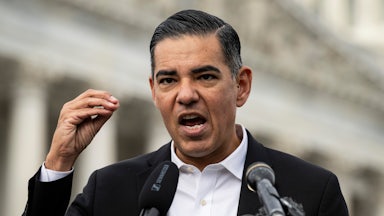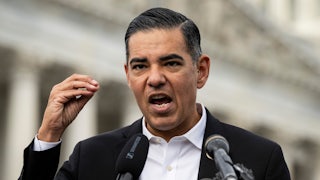The Trump administration has a problem. For the last 10 years, President Donald Trump has made anti-immigration policies the center of his political agenda. He campaigned in 2015 on throwing out Mexicans and Muslims. He promised to build a wall across the southern border. At the Republican National Convention last year, supporters even held signs saying “Mass Deportation Now!”
Those promises have gone largely unfulfilled. Naturally, this is not to downplay or dismiss some of what the Trump administration did last time or this time. But the core changes he’d hoped to create didn’t happen. Trump’s efforts to ramp up deportations barely dented the nation’s undocumented population. The Muslim ban did not seriously alter the nation’s demographics. The wall is largely unbuilt—and Trump doesn’t even really mention it anymore. Now his effort to execute mass deportations across the country is struggling.
This is not really all that surprising. Deportations are difficult; mass deportations, even more so. For an administration that values style over substance, that is built around a politics of spectacle and showmanship, and that is largely impervious to media critique, that is a problem. Its efforts to solve that “problem” may ultimately only make things worse.
All of this may explain the current situation in California. The Trump administration made a big show over the weekend of sending federal troops to Los Angeles to assist federal immigration agents who are facing protests by city residents. Some of these protests are taking place outside federal facilities where Immigration and Customs Enforcement is processing detainees for removal. Others are appearing spontaneously wherever federal agents try to carry out raids.
Trump’s rhetoric, as usual, was apocalyptic. “A once great American City, Los Angeles, has been invaded and occupied by Illegal Aliens and Criminals,” he wrote on his personal social media website on Sunday, “Now violent, insurrectionist mobs are swarming and attacking our Federal Agents to try and stop our deportation operations—But these lawless riots only strengthen our resolve.”
Trump also issued a memorandum to the attorney general, the secretary of homeland security, and the secretary of defense. Though stylized as some sort of formal presidential document, it is essentially just a fancy email. It instructs the Pentagon to assign “any other members of the regular armed forces as necessary to augment and support the protection of federal functions and property in any number determined appropriate in his discretion.” He also took steps to federalize the California National Guard, wresting it from Governor Gavin Newsom’s control.
Again, the language here was somewhat overwrought. “In addition, violent protests threaten the security of and significant damage to federal immigration detention facilities and other federal property,” the memorandum claimed. “To the extent that protests or acts of violence directly inhibit the execution of the laws, they constitute a form of rebellion against the authority of the government of the United States.”
A rebellion? Trump is perhaps the nation’s foremost expert on violent attacks on the U.S. government, but here he has missed the mark. Nobody is shooting or killing federal agents. Nobody is occupying or destroying federal buildings. A few Waymo cars have burned so far, sure, but the damage is localized and hardly severe by the city’s own standards. Los Angeles Dodgers fans torched a city bus and looted some stores after their team won their eighth World Series last October, and Trump still welcomed the team to the White House in April.
Perhaps the most curious thing about the memorandum is what it isn’t: an invocation of the Insurrection Act of 1807. Trump officials have salivated at the prospect of invoking the act since he left office, typically with an eye toward quelling anti-Trump protests. Stephen Miller, the architect of Trump’s draconian immigration policies, also proposed invoking the act when discussing his second-term agenda in 2023 to supplement existing federal personnel when carrying out his ambitious mass-deportation plans.
What do those plans entail? The White House reportedly hopes to deport about one million people during Trump’s first year in office. Trump administration officials claimed that they had deported roughly 139,000 people by the end of his first 100 days in office in April. But, as USA Today reported at the time, those numbers are hard to square with the ones disclosed by Customs and Border Protection over that same time period, which only counted about 57,000 removals.
It is possible that the administration is counting a mixture of voluntary removals, apprehensions at the border, and pending departures to inflate the numbers. Whatever the source, even the administration appears to recognize behind closed doors that it is not meeting its already extraordinary goals. Axios reported last month that Miller, who currently serves as the White House’s domestic policy chief, yelled at ICE officials in a mid-May meeting for not arresting enough people, leaving some participants with the impression that their jobs were in danger.
What’s the big holdup? Logistics are the primary issue. It is not easy to track down millions of immigrants, even if you have a decent idea of where they might be. There are only so many ICE agents, so many facilities to hold prospective targets for deportations, so many immigration judges to hold deportation hearings, so many flights that can be chartered to the deportees’ home countries, and so many countries willing to cooperate with this process. The Trump administration recognizes this: Its omnibus bill currently up for debate in Congress would set aside billions to hire new ICE agents and support staff.
At the same time, the Trump administration appears to be prioritizing spectacle over substance. The raids in Los Angeles appear designed more to provide fodder for right-wing broadcasts—and to forestall another shouting episode from Miller—than to actually achieve significant numbers of removals. Federal officials brought Dr. Phil along with them so he could film an episode for a television show; meanwhile, the city of Glendale responded to public blowback by ending its agreement to detain suspected immigrants on behalf of ICE, which will make it harder for the agency to do its job.
Legality is another concern. The Supreme Court is far from hostile to the Trump administration’s current deportation agenda: It cleared the way for Trump to revoke temporary protected status from about 350,000 Venezuelans in May and allowed him to effectively wipe out the humanitarian parole program that protected about 500,000 immigrants from deportation proceedings. But the blowback from the Kilmar Abrego Garcia case—including the court’s unanimous order that underscored that all foreign nationals must receive due process before deportation—may have hindered some of the administration’s plans.
One unusual option that the administration has explored would be to send deportees to a third country. This isn’t without precedent in the United States: Under the Obama administration, Guantánamo Bay detainees who couldn’t be repatriated to their home countries were sent to a wide range of other places, including Palau, Senegal, Serbia, the United Arab Emirates, and so on. Though the removals were not technically deportations since the detainees never reached U.S. soil, the Obama administration had to devote significant diplomatic resources to the effort over the course of eight years to resettle roughly 150 detainees.
Other countries have embarked on similar plans, albeit without much success. In the United Kingdom, where immigration is also a major political issue, multiple Conservative governments spent more than two years between 2022 and 2024 on an ambitious scheme to send tens of thousands of migrants to Rwanda. Under the plan, President Paul Kagame’s regime would receive millions of pounds in compensation and development aid in exchange for accepting the migrants’ asylum claims and allowing them to reside there.
But the plan foundered. British courts blocked the policy from going into effect—an exceedingly rare move in their political system—after the migrants’ lawyers questioned the lawfulness of deporting them to an authoritarian country. Despite Parliament’s efforts to overturn the court ruling, public opposition and logistical hurdles meant that only a handful of migrants were sent to Rwanda before the Labour Party won in 2024. Prime Minister Keir Starmer’s government canceled the plan last July because of its exorbitant cost, claiming that the Tories had spent more than $900 million on it without any tangible results.
Indeed, Trump’s own efforts to send people to third countries have hit their own series of legal and logistical roadblocks. The Supreme Court barred the administration from sending further flights of Venezuelans who were accused of membership in an international prison gang without providing hearings where they can contest those allegations. Federal courts have also intervened to block other ad hoc deportation efforts, including efforts to deport non-nationals to unstable African countries like Libya and South Sudan, some of which are in the middle of civil wars.
One of the Trump administration’s problems is that it is high on its own supply. It has often depicted the United States as occupied by teeming throngs of violent migrants and international gang members. Now it is struggling to discover that its bigoted perception is not actually the reality. Miller, for example, reportedly shouted at ICE officials to carry out more raids at Home Depot, apparently driven by the common perception that large numbers of undocumented day laborers are milling around there. ICE has followed suit at Home Depot stores in and around Los Angeles County, all without much apparent success.
I do not doubt the Trump administration’s desire to remove as many immigrants from the U.S. as possible, nor do I dispute that its authoritarian tendencies are shaping events here at home. There appears to be an ideological desire to punish California and inflict harm upon its residents and elected officials because it happens to be a big blue state. (Trump even threatened to arrest Governor Gavin Newsom, for no apparent reason, on Monday.) At the same time, they don’t appear to be very good at this on a practical level, and they don’t have any answers for their shortcomings other than these sporadic and legally dubious shows of force. The real question now is how much damage they’ll do to the rule of law and the Union along the way.










